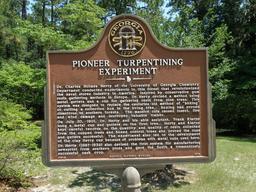Transfert en cours..., vous êtes sur le "nouveau" serveur data.abuledu.org dont l'hébergement est financé par l'association abuledu-fr.org grâce à vos dons et adhésions !
Vous pouvez continuer à soutenir l'association des utilisateurs d'AbulÉdu (abuledu-fr.org) ou l'association ABUL.
Suivez la progression de nos travaux et participez à la communauté via la liste de diffusion.
Votre recherche ...
Nuage de mots clés
Photographie, Ateliers, Industrie, Poix, Distillation, Bordeaux (Gironde), Écomusées, Gemmage, Pin maritime, Pinus pinaster, Colophanes, Luxey (Landes), Térébenthine
Distillation de la résine à Luxey
Atelier des produits résineux de Jacques et Louis Vidal à Luxey (Landes) : écomusée de la gemme, inscrit aux monuments historiques par arrêté du 19 février 1990. La térébenthine de Bordeaux, aussi appelée « poix de Bordeaux », « galipot » ou « térébenthine officinale », est la résine extraite du pin maritime (Pinus pinaster), donnant après purification et distillation l'essence de térébenthine ainsi que la colophane (résidu de la distillation).
Photographie, Anglais (langue), Pins, Plaques commémoratives, Gemmage, Térébenthine, Charles Herty (1867-1938), Expérimentation, Expérimentation botanique, Expérimentation en agriculture, Géorgie (États-Unis)
Expérimentation de gemmage en Amérique
Plaque commémorative du site expérimental de gemmage en V du Dr. Charles Holmes Herty de l'Université de Géorgie. (Georgia – 1776 PIONEER TURPENTINE EXPERIMENT. Dr. Charles Holmes Herty of the University of Georgia Chemistry Department conducted experiments in this forest that revolutionized the naval stores industry in America. Inspired by conservative gum resin gathering methods in Europe, Dr. Herty devised a method using metal gutters and a cup for gathering resin from pine trees. This system was designed to replace the centuries old method of « boxing » or cutting a collection box in the living tree. Boxing had proved disastrous to southern forests. The massive cuts caused insect, fire and wind damage and destroyed valuable timber. On July 20, 1901, Dr. Herty and his able assistant, Frank Kiarpp, hung a metal cup and gutters on the first tree. Herty and Klarpp kept careful records on the quantity and quality of resin collected from the cupped trees and box control trees and proved the cups and guttered successful. The experiment also led to the development of the clay Herty cup because of problems with metal cups used here. Dr. Herty (1867-1938) also devised the first system for manufacturing newsprint from southern pines and gave the South a tremendously successful cash crop. GEORGIA HISTORIC MARKER 1978).

